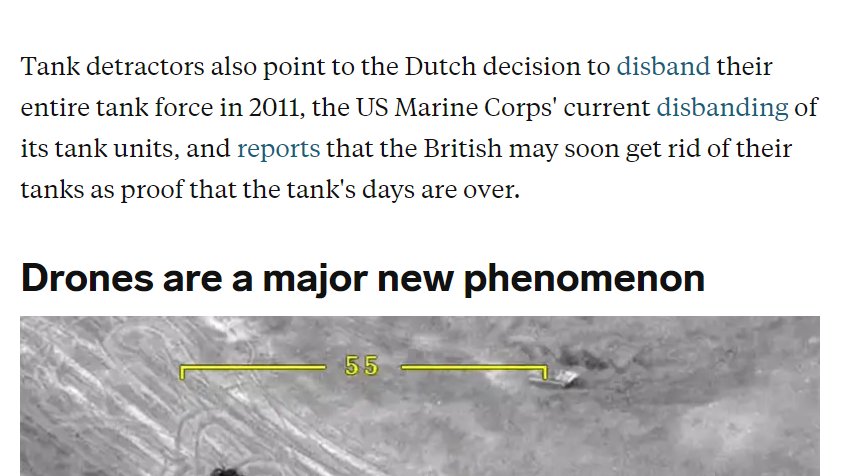Thread: Some people are questioning whether the war in Karabakh proves that the tank is obsolete. A better question to ask is how Azerbaijan was able to punch through NKR's defenses, seize fortified positions, and exploit that success in the south?
businessinsider.com/drones-in-arme…
businessinsider.com/drones-in-arme…
TB2 didn't seize fortified positions. They degraded Armenia's ability to defend its positions, but ultimately Az SOF or infantry forces had to take those positions while under fire. T-72/90S tanks, BMP-2/3, BTR-82A, SandCats, and MRAPs all played a key role supporting them. 2/
There are some obvious lessons from the conflict, but some conclusions are premature. We still have little idea of Azerbaijan's death total. If Azerbaijan sustained comparable casualties to Armenia, will people still write hyperbolic pieces about the dominance of UAVs? 3/
That isn't to say UAVs weren't critical, but they were just one part and Az soldiers still had to take fortified defensive positions, likely sustaining heavy casualties. Both sides have posted countless videos of the bodies of soldiers killed by small arms fire. 4/
That's why combined arms is a thing. Any single component has its weaknesses than are mitigated by other assets. Infantry by themselves will take heavy casualties when assaulting fortified positions or urban areas without tanks. Tanks by themselves are also vulnerable. 5/
From another perspective, once Armenia's tank force was significantly degraded, (they couldn't reinforce positions or counterattack with tanks) Azerbaijan was able to have significant success. Does that tell us that tanks are obsolete, or that they are vital in modern warfare? 6/
I'm of the latter view. That interpretation means that protecting your armor is critical in modern warfare, and that investments in SHORAD/EW/etc and new TTPs are necessary to protect that asset. And what will ground forces do without tanks? Is there a better alternative? 7/
Many, if not most, of the tanks struck by TB2 MAM-L munitions and possibly loitering munitions were mobility kills and not K-kills, especially with near misses. What do you think the survivability is for guys in an unarmored vehicle with a two meter MAM-L miss? Not great. 8/
And while TB2 played a very important role, their munitions weren't effective enough against NKR defensive positions. That's why we increasingly saw Su-25 laser guided bombs, EXTRA, LORA, or MLRS fire on these positions as the conflict went on. 9/
Not to mention, they aren't really capable of suppressing a defensive position. That's where artillery, mortars, cannons, grenades, machine guns, etc. come in by echelon. Much of this isn't that dissimilar to the experience of ground forces in the attack in World War II. 10/
Azerbaijan was able to have success in the south where there is relatively flat terrain, but not much in the north where the terrain is mountainous. Part of the explanation is that Azerbaijan could more effectively employ its superior armor in the south but not in the north. 11/
The Armenian military also had some weaknesses that aren't as applicable to most Western militaries. It lacks a strong air force and a strong long-range precision fire capability. Most NATO countries have air forces that could counter TB2 in the air or on the ground. 12/
We should ask the Armenians and Azerbaijanis whether they drew this lesson about the obsolesce of the tank. Azerbaijan used tanks throughout and compensated for their vulnerability to mines by placing MRAPs up front and operating with BMPs/dismounts. 13/
https://twitter.com/RALee85/status/1319307847289704448
A snapshot of the fighting in the south with Azerbaijani armor advancing as Armenian ground troops retreat. This was around the time when Azerbaijani forces began to make serious territorial gains, and armor clearly played a key role. 14/
https://twitter.com/RALee85/status/1317838003310678016
Likewise, when the weather was sufficiently overcast to hinder the operation of TB2s, Armenia threw some of their remaining tanks and BMPs into the decisive battle for Shusha. Clearly, they thought tanks still had utility. 15/
https://twitter.com/RALee85/status/1327183796270215168
It is also important to note that the Marine Corps isn't getting rid of tanks because they are obsolete, but because it is fundamentally an expeditionary light infantry force with combined arms capabilities restructuring itself to focus on China and the Asia-Pacific. 16/ 

Mobility and long-range precision fires will be more critical in that environment, and the US Army will still retain the US military's armor capabilities (and would take the lead in any land war scenario, with the Marine Corps conducting supporting/shaping operations). 17/
So tanks are less critical for the USMC, and vertical cuts are the best way to achieve significant cost savings required to afford the new, expensive capabilities it needs for the Asia-Pacific. 18/
• • •
Missing some Tweet in this thread? You can try to
force a refresh




















